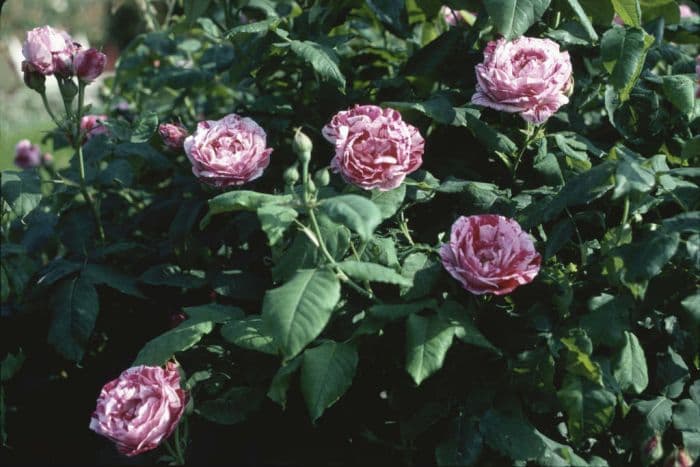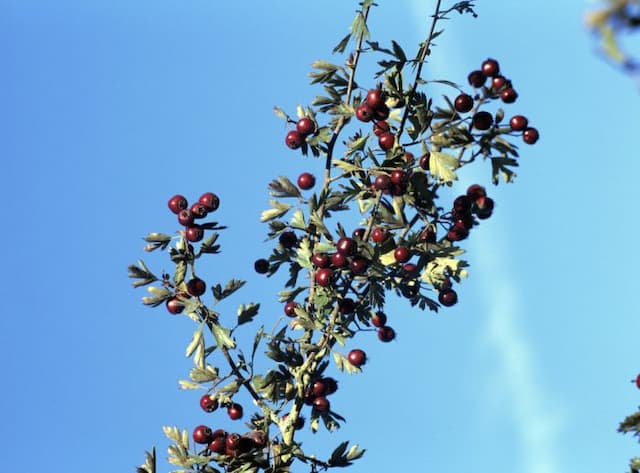Ferdinand Pichard Rose Rosa 'Ferdinand Pichard' (Bb)

ABOUT
The Rosa 'Ferdinand Pichard' is known for its striking flowers, which are the most distinguishable feature of the plant. The blooms are a captivating blend of colors, usually showcasing a mix of crimson and pink stripes, creating a unique and highly decorative effect. Each flower is densely packed with numerous petals that form a classic, tightly whorled shape that is characteristic of many rose blooms. The overall impression of the flowers is one of opulence and vivid contrast, and they typically exude a strong, pleasing fragrance that is as memorable as their appearance. As the flowers mature, the intensity of the stripes may vary, adding to the charm of the plant as it progresses through its blooming cycle. Beneath the flowers, the foliage of Rosa 'Ferdinand Pichard' forms a lush backdrop. The leaves are typically a deep green color, glossy in appearance, which further accentuates the bright hues of the blooms. As with many roses, the leaves are arranged alternately along the stems, creating a visually pleasing rhythm that contrasts with the boldness of the flowers. The stems themselves may be long and arching, bearing both blooms and foliage. They are often armed with thorns, which serve as a defense mechanism for the plant, as is common with many rose varieties. The combination of the thorns, glossy leaves, and dramatic flowers can make this rose a stand-out specimen in any garden setting, where it may serve as a focal point or a contrasting element amid different plantings. As with most roses, this variety cycles through periods of flowering, often in flushes throughout the growing season, interspersed with intervals of growth and rest. Each blooming period presents a fresh opportunity to appreciate the distinctive striped flowers, which can be a source of enjoyment both in the garden and when cut for indoor arrangements.
About this plant
 Names
NamesFamily
Rosaceae.
Synonyms
Striped Rose, Ferdinand Pichard Rose, Painted Rose, Tricolour Rose, Variegated Rose.
Common names
Rosa 'Ferdinand Pichard'
 Toxicity
ToxicityTo humans
The rose (Rosa 'Ferdinand Pichard') is generally not considered toxic to humans. Ingesting parts of this plant typically does not lead to poisoning. However, it's important to note that the thorns may cause physical injury if not handled properly, and some individuals may experience allergic reactions to the plant material.
To pets
The rose (Rosa 'Ferdinand Pichard') is also not considered toxic to pets. While eating roses is not recommended due to the potential for gastrointestinal upset from the fibrous plant material, as well as the risk of injury from the thorns, it generally does not cause serious poisoning in pets. However, large quantities could potentially lead to mild stomach upset. Care should be taken to ensure pets do not eat roses to avoid these possible consequences.
 Characteristics
CharacteristicsLife cycle
Perennials
Foliage type
Deciduous
Color of leaves
Green
Flower color
Mixed
Height
4 feet (1.2 meters)
Spread
3 feet (0.9 meter)
Plant type
Shrub
Hardiness zones
6
Native area
Cultivar
Benefits
 General Benefits
General Benefits- Aesthetic Appeal: Rosa 'Ferdinand Pichard', commonly known as the striped rose, is prized for its unique pink flowers with crimson stripes, adding a striking visual interest to any garden.
- Scent: This variety of rose is known for its strong and pleasant fragrance, which can enhance the sensory experience of a garden or outdoor space.
- Pollinator Attraction: Striped roses can attract bees and other pollinators, which are vital for the pollination of many plants and the overall health of the ecosystem.
- Landscape Versatility: These roses can be used in various garden designs, including borders, hedges, and as specimen plants, offering flexibility in landscaping choices.
- Cultural Significance: Roses have a long history of symbolism and are often associated with love, beauty, and commemoration, making them ideal for meaningful plantings and gifts.
- Garden Hobby: Growing striped roses can be a fulfilling hobby, providing gardeners with an opportunity to practice and enhance their gardening skills.
 Medical Properties
Medical Properties- Vitamin C source: Rosa species are known for their high vitamin C content in their hips (fruit).
- Anti-inflammatory: The petals may have anti-inflammatory properties.
- Antioxidant: Rose extracts are believed to have antioxidant effects.
 Air-purifying Qualities
Air-purifying QualitiesThis plant is not specifically known for air purifying qualities.
 Other Uses
Other Uses- The petals of the Ferdinand Pichard rose can be used to create natural dyes for fabrics or papers, providing a range of pink hues.
- Rosewater made from Ferdinand Pichard roses can serve as a flavoring agent in culinary arts, especially in Middle Eastern desserts.
- Its dried petals can be incorporated into potpourri mixes, adding a delicate fragrance to home decor.
- The essential oil derived from Ferdinand Pichard roses can be used in perfumery, creating unique and sophisticated scents.
- Petals of the rose can be added to baths as a luxurious and fragrant addition that may promote relaxation and stress relief.
- Ferdinand Pichard rose petals can be used to craft handmade paper, providing an artistic touch with natural inclusions.
- The rose hips, which are the fruit of the rose plant, can be used to make herbal teas after proper drying and preparation.
- Dried Ferdinand Pichard petals can act as natural confetti for celebrations like weddings, providing an eco-friendly alternative to synthetic confetti.
- When frozen in ice cubes, these rose petals can add an aesthetic and flavorful enhancement to beverages during special occasions.
- The rose can be shaped and trained to create living structures such as rose tunnels or arbors in garden design.
Interesting Facts
 Feng Shui
Feng ShuiThe rose is not typically associated with specific Feng Shui practices but is generally considered to evoke love, create positive energy, and promote a sense of balance and harmony when placed in the home. They can be used in the Southwest area of a garden or room to enhance relationships and romance based on the Bagua map.
 Zodiac Sign Compitability
Zodiac Sign CompitabilityThe rose is not specifically used in astrology practice for Zodiac sign compatibility. However, roses are often associated with the planet Venus and can symbolize love and affection, which tend to be universally appreciated regardless of one's astrological sign.
 Plant Symbolism
Plant Symbolism- Love: As with many roses, Ferdinand Pichard roses are often associated with love and passion, making them a popular choice for romantic gestures.
- Beauty: The unique striped pattern and striking colors of this rose symbolize the appreciation of beauty and diversity in all its forms.
- Honor: The rose has a longstanding association with honor and respect, making Ferdinand Pichard a suitable tribute in ceremonies or as a gift to someone admired.
- Mystery: Ferdinand Pichard roses, with their unusual pattern, can also represent mystery or something that is not completely understood, alluding to the complexity and depth of emotions.
- Balance: The combination of colors in Ferdinand Pichard may symbolize balance and harmony in relationships or life.
 Water
WaterFor the Hybrid Tea Rose, it's best to water deeply and infrequently to encourage deep root growth, typically once a week with about 1-2 gallons of water per plant during the growing season. In the hot summer months, you may need to water twice a week if the soil dries out quickly. During the dormant winter months, reduce watering to every two weeks, unless there is substantial rainfall. Avoid overhead watering to prevent leaf diseases; instead, water at the base of the plant to keep the roots moist, not soggy.
 Light
LightHybrid Tea Roses thrive in full sun for at least 6-8 hours a day. The perfect spot would be one that receives morning sun, which helps to dry dew quickly, reducing the risk of disease. Avoid planting in areas that are shaded for the majority of the day, since insufficient light can lead to weak growth and fewer blooms.
 Temperature
TemperatureHybrid Tea Roses grow best in temperatures between 65 and 75 degrees Fahrenheit. They can survive in temperatures as low as 20 degrees Fahrenheit during their dormant period in winter and can tolerate summer temperatures up into the 90s. The ideal temperature will encourage healthy growth and abundant flowering.
 Pruning
PruningPrune Hybrid Tea Roses in early spring to promote healthy growth, improve air circulation, and shape the plant. Remove dead or diseased wood, thin out crowded areas, and cut back remaining canes by about one-third to one-half. The best time for major pruning is just as the buds start to swell, which can be as early as January in mild climates or as late as April in colder regions.
 Cleaning
CleaningAs needed
 Soil
SoilHybrid Tea Rose requires well-draining soil with a mix of two parts loam, one part peat moss, and one part compost to thrive. The ideal soil pH for Hybrid Tea Rose should be between 6.0 and 6.5 to ensure nutrient availability and optimal growth.
 Repotting
RepottingHybrid Tea Roses are not typically grown in containers and therefore do not require repotting. They are perennial shrubs planted outdoors with adequate spacing to accommodate their growth.
 Humidity & Misting
Humidity & MistingHybrid Tea Roses prefer outdoor conditions where the humidity is naturally regulated. They do not require specific humidity levels but perform best in moderate conditions, avoiding extreme wetness or dryness.
 Suitable locations
Suitable locationsIndoor
Ensure bright light, proper pruning, and avoid high humidity for Hybrid Tea Roses.
Outdoor
Plant in sunny spot, well-draining soil, and water deeply for Hybrid Tea Roses.
Hardiness zone
6-9 USDA
 Life cycle
Life cycleRosa 'Ferdinand Pichard', also known as the Striped Rose, begins its life cycle as a dormant bare-root plant or a potted specimen with young canes. After planting, the roots establish and new shoots emerge, entering a vegetative state where leaves develop and photosynthesis begins. This phase is followed by the flowering stage, which typically occurs in late spring to summer, where buds form and bloom into the characteristic pink and crimson striped flowers. The plant then enters the pollination stage, where insects and other pollinators visit the flowers, allowing for the production of hips (fruit containing seeds). Once the hips mature, they can be collected for propagation or left on the plant to naturally disperse seeds, potentially giving rise to new plants. Finally, as temperatures drop in the fall, the rose enters a period of dormancy where growth ceases and the plant conserves energy until the next growing season.
 Propogation
PropogationPropogation time
Spring-Early Summer
The Rosa 'Ferdinand Pichard', commonly known as the striped or variegated rose, is often propagated through the method of softwood cuttings. This process typically occurs in late spring to early summer when the rose's new growth is still tender and green, but sufficiently matured that it snaps when bent, a state that often coincides with the period after the first flush of blooms has started to fade. To propagate by softwood cuttings, one would cut a 4 to 6 inch (approximately 10 to 15 cm) portion of a healthy stem that has recently bloomed, ensuring there are at least three sets of leaves. The lower leaves are removed, and the cut end dipped into a rooting hormone powder to encourage root development. The prepared cutting is then planted in a mix of equal parts sand and peat or a well-draining potting medium, kept moist, and covered with a plastic bag or placed in a propagator to maintain high humidity. Roots typically begin to form within 3 to 4 weeks.









